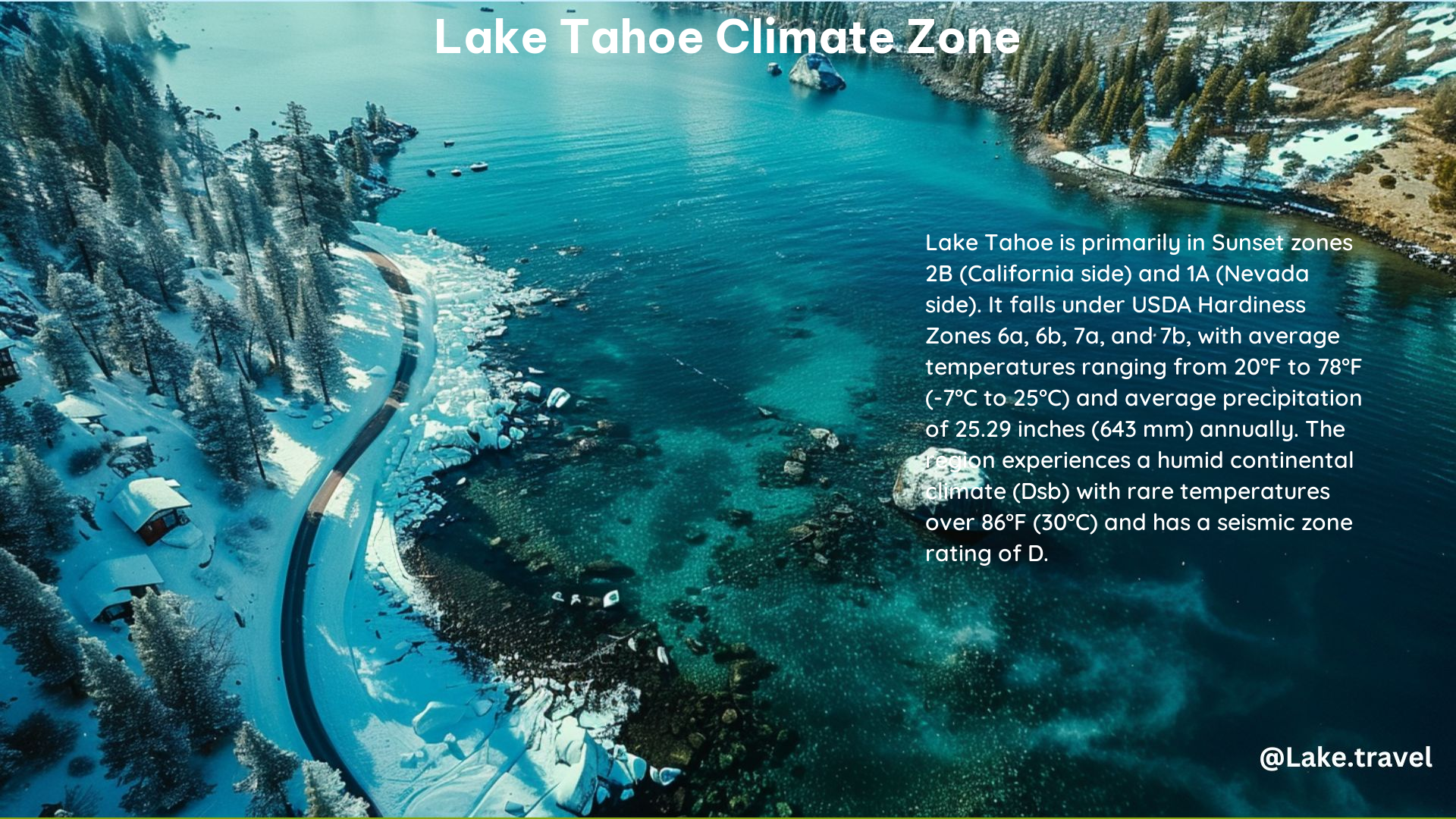Lake Tahoe, a renowned destination for outdoor enthusiasts, is located in a unique climate zone that significantly impacts the region’s weather patterns, vegetation, and construction requirements. As a Lakes Touring Enthusiast, understanding the intricacies of the Lake Tahoe Climate Zone is crucial for planning your adventures and ensuring your comfort throughout your stay.
Defining Lake Tahoe’s Climate Zone
According to the California Energy Efficiency Standards, Lake Tahoe is situated in Climate Zone 16. This climate zone is characterized by its high elevation, with an average elevation of around 6,225 feet (1,900 meters) above sea level. The region experiences a continental Mediterranean climate, which is marked by warm, dry summers and cold, snowy winters.
Temperature Variations and Hardiness Zones

The temperature variations in the Lake Tahoe area are quite significant, with average summer temperatures ranging from the 70s to 80s Fahrenheit (21°C to 27°C) and average winter temperatures dipping below freezing, often reaching the 20s Fahrenheit (-6°C to -3°C). These temperature extremes have a direct impact on the region’s hardiness zones, which are used to determine the suitability of various plant species.
The Lake Tahoe area is classified into several USDA Hardiness Zones, including:
| Hardiness Zone | Average Annual Minimum Temperature |
|---|---|
| 6a | -10°F to -5°F (-23°C to -21°C) |
| 6b | -5°F to 0°F (-21°C to -18°C) |
| 7a | 0°F to 5°F (-18°C to -15°C) |
| 7b | 5°F to 10°F (-15°C to -12°C) |
These hardiness zones help gardeners and landscapers select plants that are well-suited to the local climate, ensuring their long-term survival and thriving.
Precipitation and Snowfall
The Lake Tahoe region experiences a significant amount of precipitation, with the majority of it falling as snow during the winter months. The average annual snowfall in the area can range from 150 inches (380 cm) to over 400 inches (1,000 cm), depending on the specific location and elevation.
The high snowfall levels have a profound impact on the region’s infrastructure, transportation, and recreational activities. Ski resorts and winter sports enthusiasts thrive in this snowy environment, while the local communities must be prepared to handle the challenges of snow removal and winter driving conditions.
Energy Efficiency Requirements
The unique climate of Lake Tahoe has also led to specific energy efficiency requirements for new buildings and renovations in the area. As part of the California Energy Efficiency Standards, Climate Zone 16 has the following insulation requirements:
- Ceiling insulation: R-38
- Wall insulation: R-19
- High-efficiency glass
These insulation and glazing standards are designed to ensure that new buildings in the Lake Tahoe area are energy-efficient, reducing the energy consumption required for heating and cooling. This not only benefits the environment but also helps homeowners and businesses save on their energy bills.
Adapting to the Lake Tahoe Climate
For Lakes Touring Enthusiasts, understanding the Lake Tahoe Climate Zone is crucial for planning your activities and ensuring your comfort during your stay. Here are some tips for adapting to the unique climate:
- Dress in Layers: The temperature can fluctuate significantly throughout the day, so it’s important to dress in layers that can be easily added or removed as needed.
- Protect Yourself from the Sun: The high elevation and clear skies in the Lake Tahoe area can make the sun’s rays more intense. Be sure to wear sunscreen, hats, and sunglasses to protect your skin and eyes.
- Hydrate Regularly: The dry climate can lead to dehydration, so it’s important to drink plenty of water throughout your activities.
- Plan for Changing Weather: Be prepared for sudden changes in weather, as the Lake Tahoe area can experience rapid shifts in temperature, precipitation, and wind conditions.
- Choose Appropriate Gear: When participating in outdoor activities, select gear and equipment that is designed for the Lake Tahoe climate, such as warm, waterproof clothing and sturdy hiking boots.
By understanding the unique characteristics of the Lake Tahoe Climate Zone, you can better prepare for your Lakes Touring adventures and ensure a comfortable and enjoyable experience.
Conclusion
The Lake Tahoe Climate Zone is a fascinating and complex environment that has a significant impact on the region’s weather, vegetation, and construction requirements. As a Lakes Touring Enthusiast, embracing the unique challenges and opportunities presented by this climate zone can enhance your appreciation for the natural beauty and outdoor activities that make Lake Tahoe such a beloved destination.
References:
- https://www.plantmaps.com/96150
- https://ucanr.edu/sites/mglaketahoe/Gardening_in_Tahoe/Tahoe_Friendly_Garden_Program/Additional_Resources/Planting_Zones_in_Lake_Tahoe/
- https://9662473e561b2ca15fec-e991096dabe6d2069d3f005000c6b73d.ssl.cf2.rackcdn.com/CoolWallCoating_EligibleZipCodes.pdf
